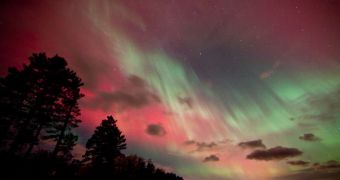Aurora borealis, also known as the Northern Lights, can produce faint, clap-like noises, scientists confirmed following a recent study. The phenomenon was first revealed in folktales and travel journals, but no conclusive evidences to support the claim were ever produced.
Now, researchers at the Aalto Universiyt, in Finland, were able to determine that the Northern Lights are indeed accompanied by their own applauses, or clapping show. Interestingly, team leader Unto Laine explains, the noises are generated by the same particles that trigger the light show.
According to the researchers, the noises originate just 70 meters (230 feet) in the air, which is very close to the ground, especially when compared to the altitudes at which the lights form, Space reports.
The clapping noises cannot be readily heard against a noisy environment. They appear to be faint in nature, and require concentrated listening to make out. However, the main conclusion of this research is that they do exist, the first time this was confirmed scientifically.
“In the past, researchers thought that the aurora borealis was too far away for people to hear the sounds it made. This is true,” Laine explained in a statement released to the media on Monday, July 9.
“However, our research proves that the source of the sounds that are associated with the Aurora Borealis we see is likely caused by the same energetic particles from the Sun that create the northern lights far away in the sky,” the expert went on to add.
“These particles or the geomagnetic disturbance produced by them seem to create sound much closer to the ground,” he added. In order to conduct the investigation, the team set up three microphones at an area of intense auroral activity, and then compared the sounds each of them captured.
What was immediately made obvious is that not every Aurora light outburst produces the brief and faint clapping sound. The exact mechanisms that lead to the sounds being emitted is still mysterious, and will require further investigations.
Another interesting discovery is that the range of sounds auroras appear to produce is very diverse, and includes sputtering noises, muffled bands, claps and crackles. Therefore, several triggering mechanism may be at work, the team hypothesizes.
Details of the new research will be showcased at a presentation the team will hold during the 19th International Congress on Sound and Vibration. The conference is being held in Vilnius, Lithuaniam between July 8-12.

 14 DAY TRIAL //
14 DAY TRIAL //